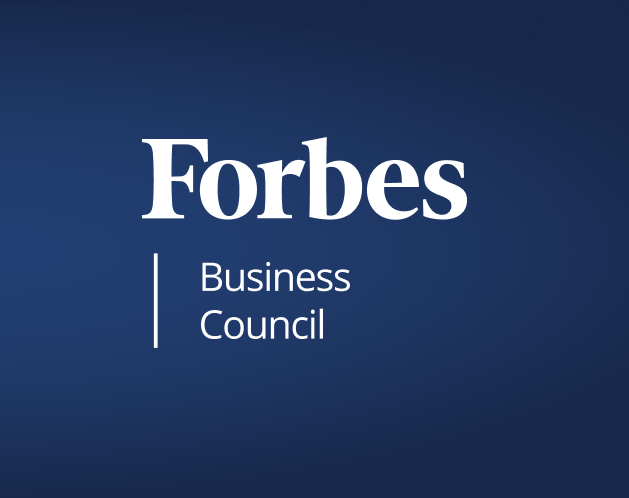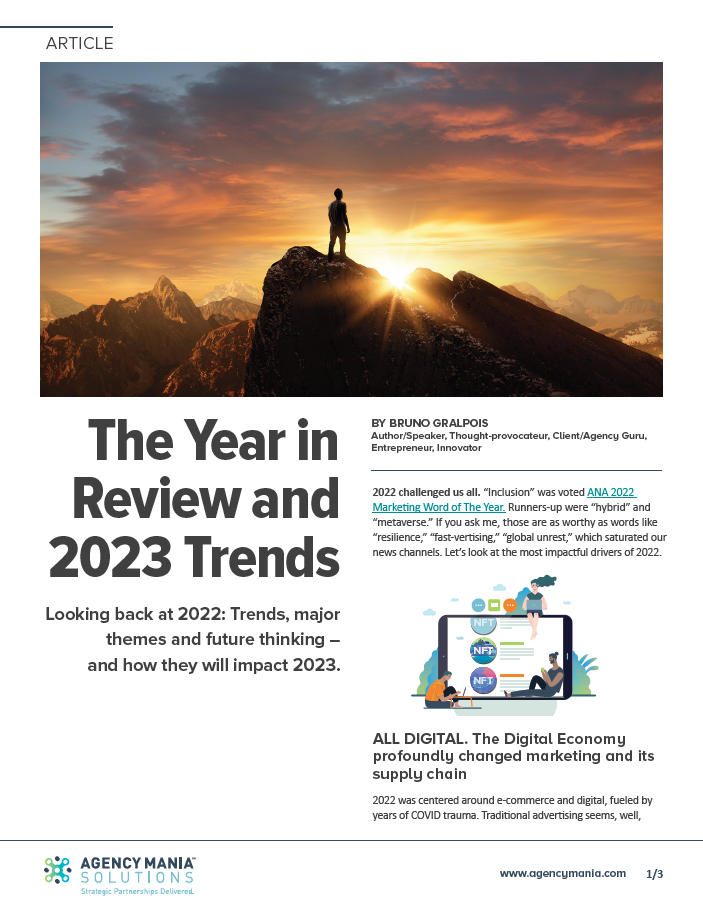— Read our article posted on Forbes —
2022 challenged us all. “Inclusion” was voted ANA 2022 Marketing Word of The Year. Runners-up were “hybrid” and “metaverse.” If you ask me, those are as worthy as words like “resilience,” “fast-vertising,” “global unrest,” which saturated our news channels. Let’s look at the most impactful drivers of 2022.
ALL DIGITAL. The Digital Economy profoundly changed marketing and its supply chain
2022 was centered around e-commerce and digital, fueled by years of COVID trauma. Traditional advertising seems, well, dated. Digital now accounts for the majority of ad spend, and a new supply chain composed of specialized firms is emerging to support it. In 2026, digital ad spend is forecast to account for 80.9% of total media spend. Digital is ruling the ad world. Brands experimented with digital-native concepts – NFTs, AR/VR, AI, and the metaverse. Agencies such as Accenture’s Nth Floor and WPP’s Metaverse Foundry built dedicated metaverse practices.
NOW. Everything is now built for speed
In 2022, brands wanted to accelerate their efforts, innovate, test, learn quickly, and ultimately move at the speed of cultural moments. 2022 was the year of “fast-vertising.” Hybrid work officially changed agency culture but also how work got done with a constant focus on efficiency, productivity, and time savings. Technology has been (and continues to be) a huge enabler of that. We are experiencing tremendous acceleration in agency capabilities, how talent is managed, and the way work is being produced. It’s clear that the path is forward and built for speed.
DOING (MORE) GOOD. Responsible marketing is grounded into a lasting social agenda
Commitment to diversity and inclusion became a reality. Yet, consumers had far greater ambitions for what being responsible mean. The “activist generation,” Gen Z, is all about more purposeful consumerism, across a wide range of environmental, political, and economic issues. It has significant long-term operational impact, such as reducing carbon emissions generated by advertising. Some agencies like Edelman announced that it would “part ways with clients” that don’t adhere to its environmental, social, and governance guidelines.
TOO COMFORTABLE? Brands are changing agencies faster and more frequently
A study indicated that 69% of advertisers have recently made or plan to make changes to their agency roster. In media, there were 100+ pitches in the US alone in 2022, for a value of $10 billion. And it’s far from being over: 38% of advertisers are likely to end their current ad agency relationship. Many brands say they had too many agency partners and want to simplify, streamline, and reduce excessive overhead. The message is clear: don’t get too comfortable. Kicking off a review is now a fundamental recurring business practice.
STRONG(ER). Holding companies rode the wave and have record financial results
Holding companies bounced back (financially) and broke financial records with double-digit, organic growth and profits. The global networks are back on the rise after a pre-pandemic slump as clients seek integrated partners over independent agencies. They cut expenses. Profitability soared in 2022. Publicis Groupe’s operating margin is close to 18%. Even the smaller players like S4 Capital and Stagwell grew significantly in 2022 with record financial performance, showing that the entire sector is healthy.
MAINSTREAM. In-house agencies became an inevitable reality for brands
The in-house agency phenomenon accelerated and matured. Today, 80% of brands have an in-house agency of sort, and those who don’t are considering establishing one. So in-house agencies are now mainstream. They are ramping up in size. Beyond co-existing, in-house agencies are an important part of how brands work with their external agencies as well. The drivers to move to an in-house model hasn’t change much: cost savings, improved speed. and increased productivity. Agencies are embracing flexible business models to address macro uncertainty.
TIGHTENING. Brands and agencies prepare for difficult economic times
The world struggled with global economic challenges – the war in Ukraine, the lasting effects of the COVID-19 pandemic, rising inflation, and supply-chain disruptions, caused uncertainty and volatility in the entire industry. Companies had no choice but to prepare for potentially worsening economic conditions. Advertising costs were expected to rise 5.2% globally. Thankfully, the industry benefited from a vibrant midterm election in the US and FIFA World Cup. As expected, effective and rigorous expense management are now urgent priorities.
2022 was the year of records and surprises. The 100 Best Global Brands exceeds $3 trillion in brand value for the first time—a 16% increase since 2021 – showing the resilience of this industry. 2022 proved to be a year of learning and adjustments for most. With some setbacks, it wasn’t all pretty. The macroeconomic struggles fueled innovation and prompted faster experimentation, as is often the case in challenging times. Brands and agencies built stronger relationships under pressure. They learned to do things differently. As challenges mount, that client/agency partnership has never been more important than it is today.
By Bruno Gralpois, Author/Speaker, Thought-provocateur, Client/Agency Guru, Entrepreneur, Innovator
February 14, 2023







